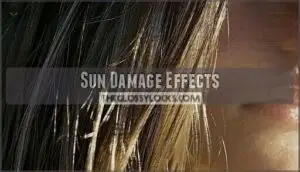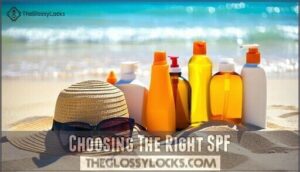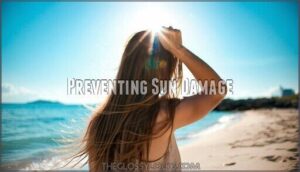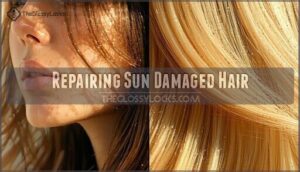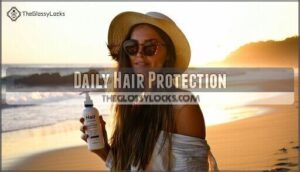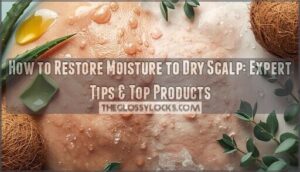This site is supported by our readers. We may earn a commission, at no cost to you, if you purchase through links.
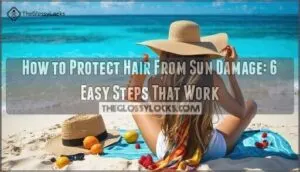 Sun’s rays can turn your hair into a straw-like mess faster than you’d think.
Sun’s rays can turn your hair into a straw-like mess faster than you’d think.
To protect hair from sun damage, start with the basics: wear a wide-brimmed hat or wrap a colorful scarf around your locks. These simple accessories act like a personal shade umbrella for your strands.
Hair sunscreen with SPF 30 works wonders too, especially on your scalp where hair’s thinnest. Apply it like you would regular sunscreen, focusing on your part line.
Don’t forget to reapply every few hours during beach days. Your hair’s color, texture, and overall health depend on these protective measures.
Smart nutrition choices can boost your hair’s natural defenses even further.
Table Of Contents
- Key Takeaways
- Sun Damage Effects
- Protecting Hair From Sun
- Hair Sunscreen Benefits
- Preventing Sun Damage
- Repairing Sun Damaged Hair
- Daily Hair Protection
- Frequently Asked Questions (FAQs)
- How to protect your hair from sun damage?
- How do I protect my hair from direct sunlight?
- How does sun damage your hair?
- Does your hair protect your scalp from the Sun?
- How to repair damaged hair after sun exposure?
- How do you protect your hair from UV rays?
- How can I prevent my hair from getting sun damage?
- Can sun damaged hair be repaired?
- How to reverse UV damage to hair?
- Can your hair get damaged by the sun?
- Conclusion
Key Takeaways
- Wear physical barriers like wide-brimmed hats and scarves – These create the most effective shield against UV rays, blocking direct sunlight from reaching your strands and scalp.
- Apply hair sunscreen with SPF 30 or higher – Use products specifically designed for hair protection, focusing on your part line and reapplying every few hours during extended sun exposure.
- Nourish your hair from within through smart nutrition – Eat foods rich in vitamin C, beta carotene, and antioxidants to strengthen your hair’s natural defenses against sun damage.
- Use deep conditioning treatments and gentle care routines – Apply hydrating masks weekly, wash with sulfate-free shampoos, and trim damaged ends regularly to maintain healthy, protected hair.
Sun Damage Effects
When you spend time in the sun without protection, UV rays act like invisible bleach on your hair, breaking down the protective cuticle layer and leaving strands dry, brittle, and prone to breakage.
UV rays silently strip your hair’s natural defenses, leaving behind brittle, lifeless strands that beg for protection.
You’ll notice your hair becomes harder to manage, loses its natural shine, and may even change color as the sun’s rays strip away melanin pigments that give your hair its natural hue.
Dryness and Brittleness
When your hair faces the sun’s relentless rays, it becomes a victim of cuticle damage that strips away natural moisture.
Sun damaged hair loses its elasticity, leaving you with brittle strands that snap easily.
Here’s what dry hair sun exposure creates:
- Hair dryness that makes strands feel like straw
- Hair brittleness causing breakage with gentle brushing
- Split ends multiplying faster than you can trim them
- Keratin protection breaking down under UV assault
- Hydration methods becoming less effective over time
Your hair sun damage repair starts with understanding these warning signs to address the issue of hair dryness.
Color Change and Premature Graying
Beyond dryness, UV exposure acts like a slow bleach on your strands.
Sun rays destroy melanin, causing hair discoloration and premature graying by damaging keratin at the molecular level.
Your hair color fades gradually, and gray hairs turn yellow from oxidative stress.
| UV Damage Type | Hair Effect | Prevention Method |
|---|---|---|
| Melanin Loss | Color fading | Daily SPF protection |
| Keratin Damage | Structural weakness | Antioxidant treatments |
| Oxidative Stress | Premature graying | Graying prevention serums |
| Free Radicals | Yellow tinting | Color protection products |
| Protein Breakdown | Texture changes | Protect color treated hair |
Vulnerable Hair Types
Some hair types face greater sun vulnerability than others.
Fine hair lacks the protective thickness to shield against UV rays, while light hair contains less melanin for natural defense.
Chemically treated strands already have compromised cuticles, making them extra fragile.
Thinning hair exposes more scalp to damage, and dry hair absorbs UV radiation like a sponge, increasing hair fragility substantially.
Protecting Hair From Sun
Just like your skin needs protection from harmful rays, your hair craves the same attention during sunny days.
UV hair damage occurs when solar radiation penetrates your hair’s protective cuticle, breaking down proteins and stripping away natural moisture.
Think of sun protection hair care as your first line of defense against brittle, faded strands.
Summer haircare becomes essential when you consider how quickly UV rays can transform healthy locks into dry, unmanageable hair.
Your scalp faces particular risk, as scalp sunburns can damage hair follicles and affect growth patterns.
UV Hair Shields work by creating a barrier between your strands and damaging radiation.
Hydration Importance can’t be overstated—well-moisturized hair withstands sun exposure better than dry hair.
Protective styling, like braids or buns, reduces surface area exposed to UV rays.
Combined with proper hair sunscreen and UV protection hair products, these strategies keep your locks looking vibrant all season long.
This approach emphasizes the need for proper hair care and hydration to maintain healthy hair.
Hair Sunscreen Benefits
You’ve probably slathered sunscreen on your skin countless times, but your hair needs UV protection too since sun rays can bleach and damage your strands just like they harm your skin.
Hair sunscreen creates a protective barrier that shields your hair cuticles from harmful UV radiation, helping maintain your color and preventing the dry, brittle texture that comes from too much sun exposure, which can be damaging to your hair cuticles and overall hair health.
How It Works
Hair sunscreen’s protection works differently than your skin’s SPF.
UV filters like avobenzone and zinc oxide either absorb or reflect harmful rays before they penetrate each hair strand.
This creates a protective barrier around your hair cuticle, preventing damage that causes dryness and brittleness.
However, scalp coverage requires different SPF products since hair sunscreen focuses on strand protection, not cellular damage prevention.
Applying to Scalp
Your scalp needs dedicated sun protection beyond hair sunscreen.
Don’t forget your scalp—it needs its own SPF shield, separate from your hair protection routine.
Regular skin SPF products work best for preventing scalp sunburn, while hair-specific formulas protect strands.
Apply mineral sunscreen with SPF 30 directly to your part line and exposed scalp areas.
For a variety of options, consider scalp sunscreen with SPF.
Spray formulas designed for scalp sun protection won’t leave your hair greasy or chalky like traditional lotions, providing an effective way to prevent scalp sunburn.
Choosing The Right SPF
When shopping for hair sunscreen, you’ll want SPF 30 or higher for extended outdoor time.
Look for broad spectrum protection that blocks both UVA and UVB rays.
Consider your hair type – fine hair needs lightweight formulas while thick hair can handle richer products.
Check product reviews to find options that won’t leave residue or weigh down your strands, ensuring a suitable choice for your hair with broad spectrum protection.
Preventing Sun Damage
You can take several proactive steps to shield your hair from harmful UV rays before damage occurs, much like how you’d protect your skin with sunscreen and smart choices.
These prevention strategies work together to maintain your hair’s health, color, and strength throughout the sunny months.
Avoiding Chemicals
Chemical treatments can weaken your hair’s natural defenses against sun damage. Skip harsh products that strip away protective oils, leaving strands vulnerable to UV rays.
- Choose sulfate-free shampoos with natural ingredients like shea butter instead of chemical-laden formulas
- Avoid chemical-free styling products that contain alcohol, which dries out hair further
- Embrace organic haircare and DIY recipes using coconut oil for natural sun protection for hair
Eating Right
Smart nutrition choices strengthen your hair from the inside out.
Your Nutrient Intake directly impacts hair health, while proper Hydration Levels maintain natural hair shine.
Foods rich in vitamin C and beta carotene provide Antioxidant Boost protection.
Quality Protein Sources support hair protein structure, and Mediterranean diet patterns offer thorough Vitamin Support for ideal hair nourishment and hair hydration.
| Nutrient Category | Key Foods | Hair Benefits |
|---|---|---|
| Vitamin C Sources | Citrus fruits, strawberries, spinach | Fights free radicals, supports collagen |
| Beta Carotene Foods | Carrots, kale, sweet potatoes | Natural sun protection, antioxidant power |
| Protein Sources | Fish, beans, nuts | Strengthens hair structure and growth |
| Hydration Boosters | Water, herbal teas, fruits | Maintains shine, prevents dryness |
| Antioxidant-Rich | Berries, green tea, dark chocolate | Repairs damage, protects hair cells |
Accessorizing Smart
Wide-brimmed hats offer stylish protection while blocking harmful UV rays from reaching your scalp and strands.
Choose hat materials with UPF ratings for maximum coverage.
Hair scarfs work beautifully for scarf styling – wrap them around a sleek hair bun for double protection.
Don’t forget sunglasses pairing to complete your look while safeguarding nearby hair from reflected sunlight, providing an extra layer of protection.
Using Right Conditioner
Moisture becomes your hair’s best friend when battling sun damage. Choose conditioners with UV-filtering ingredients like zinc oxide or natural oils that create protective barriers.
Leave-in benefits include continuous hydration and heat protection throughout the day. Deep conditioning treatments once weekly restore elasticity and shine.
For specialized care, consider exploring a hair UV conditioner. Apply from mid-length to ends, focusing on damaged areas for maximum summer hair care protection.
Repairing Sun Damaged Hair
If you’ve already noticed your hair feeling dry, brittle, or looking dull from sun exposure, don’t worry—you can restore its health with targeted repair treatments.
While prevention works best, these simple repair methods will help bring damaged strands back to life and prepare them for better protection moving forward.
DIY Hot Oil Treatment
When sun damage has already taken its toll, hot oil treatment becomes your hair’s best friend.
This time-tested remedy deeply nourishes damaged strands and restores lost moisture.
- Oil Selection: Choose coconut, olive, or argan oil based on your hair type
- Heating Methods: Use double boiler method, never microwave to preserve nutrients
- Application Techniques: Massage warm oil from scalp to ends for even coverage
- Treatment Frequency: Apply 1-2 times monthly for ideal hair damage prevention
- DIY Recipes: Mix oils with essential oils like rosemary for enhanced benefits
Getting a Trim
Trimming damaged ends isn’t just about style maintenance—it’s essential hair damage prevention.
Split end removal every 6-8 weeks stops breakage from traveling up your hair shaft.
Professional trimming eliminates sun-damaged sections that can’t be repaired, allowing healthy hair growth to flourish.
Think of it as pruning a plant; removing damaged parts helps the rest thrive and prevents further hair thinning.
Daily Hair Protection
You can prevent sun damage by incorporating simple protective habits into your daily routine, just like you’d apply sunscreen to your skin.
These everyday practices help maintain your hair’s strength, color, and moisture while shielding it from harmful UV rays that cause dryness, brittleness, and fading, which is crucial for preventing damage.
Wearing Hat or Scarf
Physical barriers offer your hair the ultimate shield against harmful UV rays.
A wide-brimmed hat with UPF protection becomes your hair’s best friend, providing complete hair coverage while maintaining style.
Consider these fabric choices and style options for ideal hair protection:
- Tightly woven materials – Dense fabrics block more UV rays than loose weaves
- UPF-rated accessories – Look for Ultraviolet Protection Factor ratings of 30+
- Secure fit options – Choose adjustable bands to prevent wind displacement
- Versatile style options – Scarves, bandanas, and hats suit different occasions
- All-weather wear – Maintain hair wrapping habits even on cloudy days for consistent sun protection
Using Sunscreen With SPF 30
When choosing hair sunscreen, prioritize products with at least SPF 30 for adequate SPF effectiveness against harmful UV rays.
Look for product ingredients like zinc oxide or avobenzone that provide broad-spectrum protection.
Focus on scalp coverage by applying the hair SPF directly to your part line and exposed areas, which guarantees thorough hair sun protection throughout your day with broad-spectrum protection.
Reapplying Sunscreen Regularly
Like clockwork, your hair sunscreen reapplication schedule determines protection effectiveness. Hair sunscreen application requires consistent protection every three hours during sun exposure.
Post-swim reapply immediately after toweling off, as water strips protective barriers. Product layering enhances coverage—spray roots, then lengths.
Maintaining hydration through regular hair sun protection prevents cumulative damage. Remember, diligent reapplication frequency beats sporadic heavy application every time.
Washing Hair Gently
After protecting your hair throughout the day, proper washing becomes your evening ritual.
Use gentle shampoo types with lukewarm water to preserve hair moisture without stripping natural oils.
Focus scalp massage on removing buildup while maintaining hair and scalp health.
Reduce washing frequency to every other day, then pat-dry gently—aggressive towel drying damages sun-weakened strands.
Using Hydrating Hair Mask
Your hair craves moisture after sun exposure, making hydrating hair masks essential for summer hair protection.
Choose masks with nourishing mask ingredients like coconut or avocado oil. Apply twice weekly for ideal application frequency, focusing on damaged ends.
DIY recipes using honey and olive oil work wonderfully. Many people find hair hydration products to be very effective.
Leave-in masks provide continuous moisture, helping repair hair sun damage while restoring your hair’s natural shine and softness, which is crucial for maintaining healthy and nourishing hair with natural shine.
Frequently Asked Questions (FAQs)
How to protect your hair from sun damage?
Think of your hair as delicate silk threads under a magnifying glass.
You’ll need SPF hair products, wide-brimmed hats, and protective styles like braids.
Limit peak-hour exposure and use leave-in conditioners to shield strands effectively, which is a key part of using protective styles.
How do I protect my hair from direct sunlight?
Wear wide-brimmed hats or scarves to shield your strands from harsh UV rays.
Apply hair sunscreen with SPF protection before heading outdoors.
Seek shade during peak hours and use leave-in conditioners for extra defense.
How does sun damage your hair?
Studies show UV rays can strip up to 40% of your hair’s moisture in just hours.
Sun exposure breaks down your hair’s protective cuticle, causing dryness, brittleness, color fading, and split ends while weakening the protein structure that keeps strands strong.
Does your hair protect your scalp from the Sun?
Your hair provides minimal protection for your scalp from harmful UV rays.
While it creates some shade, it’s not enough to prevent sunburn or UV damage, especially along your part line and exposed areas.
How to repair damaged hair after sun exposure?
Like a wilted flower craving water, sun-damaged hair needs intensive care.
Apply deep conditioning masks weekly, trim split ends regularly, use leave-in treatments with proteins.
Avoid heat styling while your strands recover their strength.
How do you protect your hair from UV rays?
Use hair sunscreen with UV filters, wear wide-brimmed hats, and apply leave-in conditioners with SPF. Limit sun exposure during peak hours and rinse hair after swimming to prevent damage.
How can I prevent my hair from getting sun damage?
Apply UV-protecting hair products before sun exposure, wear wide-brimmed hats or scarves.
Limit outdoor time during peak hours, and use leave-in conditioners with SPF to shield your strands from harmful rays.
Can sun damaged hair be repaired?
Can damaged locks bounce back from summer’s harsh embrace?
You can’t fully reverse sun damage, but deep conditioning treatments, protein masks, and regular trims help restore moisture, strength, and manageability to your weathered strands over time, through regular trims.
How to reverse UV damage to hair?
Unfortunately, you can’t fully reverse UV damage to hair since it’s permanent structural damage.
However, deep conditioning treatments, protein masks, and trimming damaged ends will help restore moisture, strength, and manageability to sun-damaged strands, providing a way to improve the hair’s overall health and manageability.
Can your hair get damaged by the sun?
Yes, your hair can definitely get sun damage.
UV rays act like bleach, breaking down hair’s protective cuticle and removing color.
This leaves strands dry, brittle, frizzy, and prone to breakage and split ends.
Conclusion
Sunlight’s golden glow shouldn’t dim your hair’s natural brilliance.
These protective strategies transform your daily routine into a shield against UV damage.
Remember, knowing how to protect hair from sun damage isn’t just about summer—year-round vigilance keeps your strands healthy and vibrant.
Whether you’re applying SPF-infused products, donning a stylish hat, or nourishing from within, consistency matters most.
Your hair will thank you with improved texture, retained color, and lasting strength that withstands time’s test.

